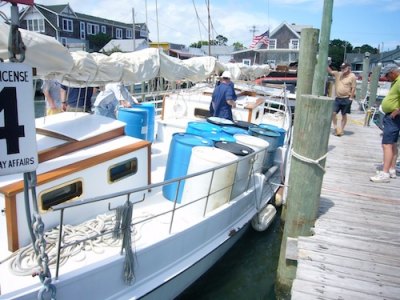Last week the Coast Guard observed a stability test performed at the dock by moving 55-gallon drums of water across the deck (to simulate a boatload of passengers rushing to one side to see a mermaid, etc.). With her nearly flat bottom and exceedingly broad beam, the old girl came through with flying colors, and was approved for 45 passengers.
On June 12, Ocracoke Alive, Inc. received a generous grant from the Outer Banks Community Foundation that will help defray the costs of outfitting the vessel to Coast Guard specifications.
Meanwhile, we’ve taken her out on a few shakedown sails to let her stretch her legs a bit. For the first couple of cruises we chose days with light winds but it wasn't until we hoisted sail in a 10 to 15 knot breeze that she showed us what she could do. From the deck, her 1800 square feet of sail is an impressive sight and the ride is much smoother than what my little 32-foot schooner provides with her relatively narrow beam and short waterline length.
The Wilma Lee arrived at her new berth at the Community Square dock in late March. The trip down from the Potomac River was more or less uneventful (which is not a bad thing!). The wind was too light for sailing on the day we pulled out of Coles Point, Virginia so we motored down to Norfolk at over nine knots. The boat's twin 150 h.p. turbo diesels might not be traditional but they sure get the job done.
We enjoyed the kind hospitality of David Briggs at Rebel Marine in Norfolk as well as a good dinner at the restaurant next door. But, even so, I didn't sleep very well that night. Nobody, including the shipwright John Morgenthaler who had thoroughly rebuilt and re-rigged the boat, could tell me exactly how tall the mast was. Before leaving the Potomac we had hoisted a tape measure up the mast by the main halyard but it was so close to the standard bridge clearance of 65' and, being uncertain of the distance between the halyard block and the masthead light, we had no way of knowing for sure if we could get under the bridges. None of us was eager to take the boat around Cape Hatteras offshore and through Ocracoke Inlet.
So at first light, I borrowed a bo'sun's chair from our host and had the crew hoist me up the mast with the tape. It came to 64.5' (not counting the VHF radio antenna). Since spring tides and adverse winds can cause the water levels to deviate, I was a bit uncomfortable with the supposed 6” margin and approached each bridge at a snail's pace, bending the radio antenna on every one of them. As I recall, only one of the six or eight fixed bridges on our route had a legible tide gauge at its base.

But, after a harrowing day on the Intracoastal Waterway, we finally made it to a peaceful anchorage in the North River below Coinjock. The next morning we motored down to Manteo in rising winds. It got so breezy in fact that we decided to lay over a day at the dock in Manteo. While there we were visited by a gentleman who said his father used to have an oyster house in Belhaven, N.C. as well as a couple of skipjacks.
The following morning we braved our final bridge for the long run down Pamlico Sound. The long waterline and broad beam (width) make for remarkably smooth sailing on the short, steep chop of the bays and sounds for which the skipjack was designed. There was an enthusiastic crowd waiting to greet us at the dock.
If you haven’t had a chance to see the Wilma Lee, come down to the Community Square dock and check her out. I’m usually around (or in Sundae’s shop, The Black Schooner nautical shop) and will be happy to answer questions.
As you begin your walk from the parking lot to the dock, you’ll see a big, rusty, triangular contraption leaning against the porch of The Black Schooner. That’s an oyster dredge, which was used for many years on the Wilma Lee in her former life up in Maryland. Mr. Carden wanted to give us four of them but we assured him that one would suffice for display purposes since we aren’t thinking of going into the backbreaking work of oyster dredging.
We didn’t know it at the time but we were taking a big chance in accepting the gift of just that one. The owner of the marine railway on the Potomac River where we hauled the boat out for painting told us that the Maryland Marine Police would throw is in jail if they caught us with it on board! We covered it up as best we could until we were safely out of Maryland waters.
Now the old dredge, like the Wilma Lee, has a new home on Ocracoke, and a new job teaching people about sailing and commercial fishing traditions.